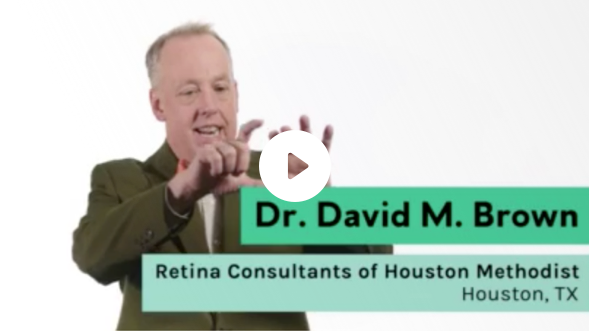Don’t Let RVO Cloud Your Future
This page contains helpful resources and information for people at all stages of their journey of living with Retinal Vein Occlusion (RVO). And because there are several types of RVO, it’s important to understand how these conditions may affect your vision so that you can talk to your doctor about finding the right path forward.

What is RVO?
RVO occurs when a blood vessel in the retina (the thin layer in the back of your eye) becomes blocked, which can cause vision loss or blurring. Sometimes, this blockage can cause fluid to leak into the macula (a small but important area in the center of the retina that helps you see details of things in front of you) a condition known as Macular Edema following Retinal Vein Occlusion (MEfRVO).
There are two major types of MEfRVO: Macular Edema following Branch Retinal Vein Occlusion (MEfBRVO) and Macular Edema following Central Retinal Vein Occlusion (MEfCRVO).
MEfBRVO
MEfBRVO occurs when one or more veins that branch out from the main retinal vein become blocked. Most cases (8 out of 10) of RVO are BRVO. MEfBRVO occurs when fluid leaks from the blocked retinal vein into the macula. MEfBRVO usually affects only one quadrant of the retina.
MEfCRVO
MEfCRVO occurs when the central retinal vein becomes blocked. Fluid then leaks into the macula because of the blocked main retinal vein. MEfCRVO usually affects up to 4 quadrants of the retina. CRVO makes up 2 out of every 10 diagnosed cases of RVO.
Review Treatment Options
If you are living with RVO, there are steps you can take with your doctor to help.
Anti-VEGF Medicines
MEfRVO is associated with unusually high levels of a protein that your body naturally produces called vascular endothelial growth factor (VEGF), which may cause leaky blood vessels that lead to vision loss. Anti-VEGF medicines are injected into the eye to attach themselves to the VEGF protein and keep these blood vessels from leaking fluid.
Laser Therapy
Laser photocoagulation (foh-toh-koh-ag-yuh-ley-shuhn) is another common treatment for MEfRVO that uses a beam of high-energy light to seal off or destroy leaking vessels and reduce the swelling that may be causing vision loss.
Steroids
Steroids are usually delivered by injection into the eye in order to reduce swelling and inflammation in the retina.
Who can develop RVO?
You are at an increased risk of developing RVO or MEfRVO if you:
- Are 50 years of age or older
- Have glaucoma
- Have arteriosclerosis
- Are overweight
- Have diabetes
- Have high blood pressure
- Are a smoker


Many of my patients often attribute vision loss or blurriness to age, however, this can sometimes be a sign of something much more serious, like a Macular Edema following Retinal Vein Occlusion, or MEfRVO. This is why I always urge my patients to monitor their vision regularly and share any changes they may experience so that we can work together to develop a plan for their vision.
How is RVO diagnosed and monitored?
One of the most commonly used ways to check for and monitor MEfRVO is an optical coherence tomography exam, which uses light waves to take pictures of the inside of your retina. Learn more by watching this video.
prep for your eye appointment
Find The Way Forward
Receiving an RVO or MEfRVO diagnosis can be scary and overwhelming. This brochure can help you understand your options and start a conversation with your doctor.



